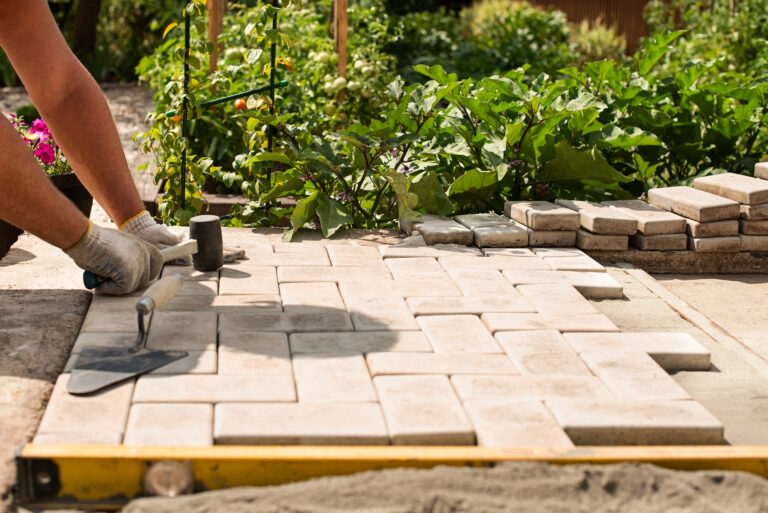How to Get Rid of Fleas in Your Backyard: Effective Solutions for a Flea-Free Outdoor Space

Fleas are a common problem for pet owners, and they can quickly spread from your pets to your yard and home. Getting rid of fleas in your backyard can be a challenging task, but it is essential to prevent the infestation from spreading. Flea infestations can cause skin irritation, allergies, and even transmit diseases to both humans and animals.
To get rid of fleas in your backyard, the first step is to identify the source of the infestation. Pets are the most common carriers of fleas, so it is important to treat your pets with flea medication regularly. However, fleas can also be carried by wild animals, such as raccoons and squirrels, or brought in by humans. Once you have identified the source of the infestation, you can begin treating your yard to eliminate the fleas.
There are several methods to get rid of fleas in your yard, including chemical and natural remedies. Chemical treatments can be effective but may pose a risk to your pets and the environment. Natural remedies, such as diatomaceous earth and nematodes, can also be effective and safer for your pets and the environment. It is important to choose the right method for your situation and follow the instructions carefully to ensure success.
Understanding Fleas and Their Life Cycle
Fleas are small, wingless insects that feed on the blood of animals and humans. They are often found in the backyard, especially in areas with tall grass, bushes, and trees. Understanding the life cycle of fleas is important in order to effectively get rid of them.
The flea life cycle consists of four stages: eggs, larvae, pupae, and adult fleas. Adult fleas lay their eggs on the host animal, which then fall off onto the ground. The eggs hatch into larvae, which feed on organic material in the environment. After a few weeks, the larvae spin a cocoon and enter the pupal stage.
The pupal stage can last for several weeks or months, depending on the environmental conditions. Once the adult flea emerges from the cocoon, it will seek out a host to feed on. Adult fleas can live for several months and lay hundreds of eggs during their lifetime.
Getting rid of fleas in the backyard requires targeting all stages of the flea life cycle. This includes treating the host animal, as well as treating the environment. Vacuuming the home and washing all bedding and linens in hot water can also help eliminate fleas.
In order to effectively treat the environment, it is important to mow the lawn regularly and remove any debris or clutter in the yard. Using flea control products, such as sprays and foggers, can also help eliminate fleas in the backyard.
Overall, understanding the life cycle of fleas is crucial in order to effectively get rid of them. By targeting all stages of the flea life cycle and treating the environment, homeowners can successfully eliminate fleas from their backyard.
Identifying a Flea Infestation in Your Yard
Flea infestations in your yard can be a nuisance for both you and your pets. Identifying the presence of fleas early on can help you take timely measures to get rid of them before they become a major problem. Here are some signs that can help you identify a flea infestation in your yard:
- Pets Scratching More Than Usual: If your pets are scratching themselves more than usual, it could be a sign that they have fleas. Check for fleas on their skin and fur, especially around the neck, tail, and belly.
- Small Black Specks on Your Pet’s Fur: Fleas leave behind droppings that look like small black specks on your pet’s fur. You can confirm the presence of fleas by placing a white towel under your pet and brushing their fur. If you see small black specks on the towel, it’s likely that your pet has fleas.
- Bites on Your Skin: If you spend time in your yard and notice small itchy bites on your skin, it could be a sign that there are fleas in your yard. Fleas usually bite around the ankles and legs.
- Tall Grass and Shady Areas: Fleas prefer to live in tall grass and shady areas. If your yard has tall grass or a lot of bushes, it’s more likely that fleas will be present.
- Flea Dirt on the Lawn: Flea dirt is the droppings left behind by fleas. If you notice small black specks on your lawn, it could be a sign that there are fleas living in your yard.
It’s important to take action as soon as you identify a flea infestation in your yard. Fleas can quickly multiply and infest your home, making it harder to get rid of them. In the next section, we’ll discuss ways to get rid of fleas in your yard.
Effective Flea Treatments for Your Backyard
Getting rid of fleas in your backyard can be a challenging task, but it is essential to keep your pets and family safe. Here are some effective flea treatments that you can use in your backyard:
Diatomaceous Earth
Diatomaceous Earth is a natural and safe way to kill fleas in your backyard. It is made from fossilized diatoms, which are tiny aquatic organisms. Diatomaceous Earth works by dehydrating the fleas, which eventually leads to their death. To use Diatomaceous Earth, sprinkle it over the affected area and leave it for a few days before vacuuming it up.
Insecticides
Insecticides are a popular choice for getting rid of fleas in your backyard. They come in different forms, including sprays, granules, and concentrates. Insecticides contain chemicals that kill fleas on contact or after they ingest the product. It is essential to follow the instructions carefully when using insecticides, as they can be toxic to pets and humans.
Nematodes
Nematodes are beneficial microscopic worms that feed on flea larvae. They are a natural and safe way to control fleas in your backyard. Nematodes are available in garden centers or online, and they come in a powder form that you can mix with water and spray over the affected area.
Flea Spray
Flea sprays are a quick and easy way to kill fleas in your backyard. They come in different forms, including aerosol and pump sprays. Flea sprays contain chemicals that kill fleas on contact and provide residual protection. It is essential to follow the instructions carefully when using flea sprays, as they can be toxic to pets and humans.
In conclusion, there are several effective flea treatments that you can use in your backyard. It is essential to choose a treatment that is safe for your pets and family and follow the instructions carefully. With the right treatment and regular maintenance, you can keep your backyard flea-free.
Preventing Future Flea Infestations
Preventing future flea infestations is crucial to maintaining a flea-free backyard. Here are some tips to help prevent fleas from returning:
- Mow the Lawn Regularly: Keeping the grass short can help reduce the flea population in your yard. Fleas love to hide in tall grass, so keeping it short will make it harder for them to find a home.
- Vacuum Regularly: Vacuuming your yard can help remove fleas and their eggs from the grass. Make sure to dispose of the vacuum bag properly, as fleas can survive inside it.
- Control Humidity: Fleas thrive in humid environments, so controlling the humidity in your yard can help prevent them from returning. Use a dehumidifier if necessary.
- Let the Sunlight In: Fleas hate sunlight, so letting the sun shine on your yard can help reduce the flea population. Trim back any overhanging branches or foliage that may be blocking the sunlight.
- Dethatch Your Lawn: Thatch buildup can provide a hiding place for fleas and their eggs. Dethatching your lawn can help reduce the flea population by removing this hiding place.
- Avoid Overwatering: Overwatering your lawn can create a humid environment that fleas love. Be sure to water your lawn only when necessary.
- Reduce Clutter: Fleas love to hide in clutter, so reducing clutter in your yard can help prevent them from returning. Remove any unnecessary items from your yard.
- Follow-Up Treatment: After treating your yard for fleas, it is important to follow up with additional treatments as needed. This can help prevent fleas from returning and keep your yard flea-free.
By following these tips, you can help prevent future flea infestations and enjoy a flea-free backyard.
Protecting Your Pets from Fleas
Fleas not only cause discomfort to your pets, but they can also transmit diseases. Protecting your pets from fleas is an important part of flea control in your backyard. Here are some effective ways to protect your pets from fleas:
- Use a flea comb: Regularly comb your pet’s fur with a flea comb to remove fleas and their eggs. This is a simple and effective way to control fleas on your pet.
- Use a flea collar: Flea collars are a popular way to protect your pets from fleas. They contain insecticides that kill fleas and prevent them from infesting your pet’s fur.
- Use flea medication: Flea medication is another effective way to protect your pets from fleas. These medications work by killing fleas and preventing them from reproducing.
- Wash pet bedding: Fleas can hide in your pet’s bedding, so it’s important to wash it regularly. Use hot water and a detergent to kill fleas and their eggs.
- Consult a veterinarian: If your pet has a severe flea infestation, it’s best to consult a veterinarian. They can recommend the best flea control products for your pet and provide advice on how to prevent future infestations.
By following these tips, you can protect your pets from fleas and keep them healthy and comfortable.
Frequently Asked Questions
What kills fleas in the yard instantly?
There are several products that can kill fleas in the yard instantly such as insecticides containing pyrethrin, permethrin, or pyrethroids. These insecticides can be sprayed on the yard, focusing on the areas where fleas are most likely to be found, such as shaded areas, under bushes, and near pet resting areas.
How to use Diatomaceous earth for fleas in yard?
Diatomaceous earth is a natural and effective way to get rid of fleas in the yard. It is a fine powder that can be sprinkled on the yard and left for a few days. The powder works by dehydrating the fleas and their larvae, causing them to die. It is important to wear a mask when applying diatomaceous earth as it can irritate the lungs if inhaled.
How to get rid of grass fleas in the house?
Grass fleas, also known as chiggers, are not actually fleas but are mites that live in grassy areas. To get rid of them in the house, it is important to vacuum carpets and furniture regularly. Washing bedding and clothing in hot water can also help. Applying insecticides that contain pyrethrin or permethrin can also be effective.
Does rain kill fleas in yard?
Rain can help to reduce the number of fleas in the yard as it can wash away flea larvae and pupae. However, it is not a reliable way to get rid of fleas as they can still survive in moist conditions.
What kills fleas naturally in your yard?
Several natural methods can be used to kill fleas in the yard such as nematodes, which are microscopic worms that feed on flea larvae and pupae. Cedar chips, eucalyptus leaves, and lavender can also repel fleas. Additionally, diatomaceous earth and vinegar can be used to kill fleas.
What attracts fleas in a backyard?
Fleas are attracted to warm and humid environments, so shaded areas with moist soil are ideal for flea breeding. They are also attracted to animals, especially dogs and cats, as they provide a warm and cozy environment for fleas to live and breed.






